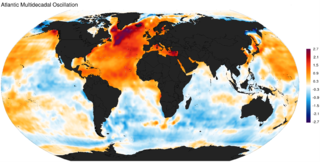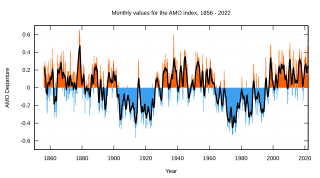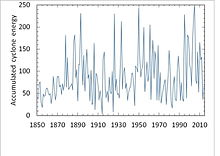Atlantic
multidecadal oscillation spatial pattern obtained as the regression of
monthly HadISST sea surface temperature anomalies (1870-2013).
Atlantic Multidecadal Oscillation Index according to the methodology proposed by van Oldenborgh et al. 1880-2018.
Atlantic
Multidecadal Oscillation index computed as the linearly detrended North
Atlantic sea surface temperature anomalies 1856-2013.
The Atlantic Multidecadal Oscillation (AMO) is a climate cycle that affects the sea surface temperature (SST) of the North Atlantic Ocean based on different modes on multidecadal timescales. While there is some support for this mode in models and in historical observations, controversy exists with regard to its amplitude, and in particular, the attribution of sea surface temperature change to natural or anthropogenic causes, especially in tropical Atlantic areas important for hurricane development.
The Atlantic multidecadal oscillation is also connected with shifts in
hurricane activity, rainfall patterns and intensity, and changes in fish
populations.
Definition
The Atlantic Multidecadal Oscillation (AMO) was identified by Schlesinger and Ramankutty in 1994.
The AMO signal is usually defined from the patterns of SST
variability in the North Atlantic once any linear trend has been
removed. This detrending is intended to remove the influence of greenhouse gas-induced global warming
from the analysis. However, if the global warming signal is
significantly non-linear in time (i.e. not just a smooth linear
increase), variations in the forced signal will leak into the AMO
definition. Consequently, correlations with the AMO index may mask
effects of global warming.
AMO Index
Several methods have been proposed to remove the global trend and El Niño-Southern Oscillation (ENSO) influence over the North Atlantic SST. Trenberth
and Shea, assuming that the effect of global forcing over the North
Atlantic is similar to the global ocean, subtracted the global
(60°N-60°S) mean SST from the North Atlantic SST to derive a revised AMO
index.
Ting et al. however argue that the forced SST pattern is
not globally uniform; they separated the forced and internally generated
variability using signal to noise maximizing EOF analysis.
Van Oldenborgh et al. derived an AMO index as the SST
averaged over the extra-tropical North Atlantic (to remove the influence
of ENSO that is greater at tropical latitude) minus the regression on
global mean temperature.
Guan and Nigam removed the non stationary global trend and Pacific natural variability before applying an EOF analysis to the residual North Atlantic SST.
The linearly detrended index suggests that the North Atlantic SST
anomaly at the end of the twentieth century is equally divided between
the externally forced component and internally generated variability,
and that the current peak is similar to middle twentieth century; by
contrast the others methodology suggest that a large portion of the
North Atlantic anomaly at the end of the twentieth century is externally
forced.
Frajka-Williams et al. 2017 pointed out that recent changes in cooling of the subpolar gyre,
warm temperatures in the subtropics and cool anomalies over the
tropics, increased the spatial distribution of meridional gradient in
sea surface temperatures, which is not captured by the AMO Index.
Mechanisms
Based on the about 150-year instrumental record a quasi-periodicity
of about 70 years, with a few distinct warmer phases between ca.
1930–1965 and after 1995, and cool between 1900–1930 and 1965–1995 has
been identified.
In models, AMO-like variability is associated with small changes in the North Atlantic branch of the Thermohaline Circulation.
However, historical oceanic observations are not sufficient to
associate the derived AMO index to present-day circulation anomalies.
Models and observations indicate that changes in atmospheric
circulation, which induce changes in clouds, atmospheric dust and
surface heat flux, are largely responsible for the tropical portion of
the AMO.
The Atlantic Multidecadal Oscillation (AMO) is important for how external forcings are linked with North Atlantic SSTs.
Climate impacts worldwide
The
AMO is correlated to air temperatures and rainfall over much of the
Northern Hemisphere, in particular in the summer climate in North
America and Europe. Through changes in atmospheric circulation, the AMO can also modulate spring snowfall over the Alps and glaciers' mass variability.
Rainfall patterns are affected in North Eastern Brazilian and African
Sahel. It is also associated with changes in the frequency of North
American droughts and is reflected in the frequency of severe Atlantic hurricane activity.
Recent research suggests that the AMO is related to the past
occurrence of major droughts in the US Midwest and the Southwest. When
the AMO is in its warm phase, these droughts tend to be more frequent or
prolonged. Two of the most severe droughts of the 20th century occurred
during the positive AMO between 1925 and 1965: The Dust Bowl of the 1930s and the 1950s drought. Florida and the Pacific Northwest tend to be the opposite—warm AMO, more rainfall.
Climate models suggest that a warm phase of the AMO strengthens the summer rainfall over India and Sahel and the North Atlantic tropical cyclone activity. Paleoclimatologic
studies have confirmed this pattern—increased rainfall in AMO
warmphase, decreased in cold phase—for the Sahel over the past 3,000
years.
Relation to Atlantic hurricanes
North Atlantic tropical cyclone activity according to the Accumulated Cyclone Energy Index, 1950–2015. For a global ACE graph visit this link.
A 2008 study correlated the Atlantic Multidecadal Mode (AMM), with HURDAT
data (1851–2007), and noted a positive linear trend for minor
hurricanes (category 1 and 2), but removed when the authors adjusted
their model for undercounted storms, and stated "If there is an increase
in hurricane activity connected to a greenhouse gas induced global
warming, it is currently obscured by the 60 year quasi-periodic cycle."
With full consideration of meteorological science, the number of
tropical storms that can mature into severe hurricanes is much greater
during warm phases of the AMO than during cool phases, at least twice as
many; the AMO is reflected in the frequency of severe Atlantic
hurricanes.
Based on the typical duration of negative and positive phases of the
AMO, the current warm regime is expected to persist at least until 2015
and possibly as late as 2035. Enfield et al. assume a peak around 2020.
Since 1995, there have been nine Atlantic hurricane seasons considered "extremely active" by Accumulated Cyclone Energy - 1995, 1996, 1998, 1999, 2003, 2004, 2005, 2010 and 2017.
Periodicity and prediction of AMO shifts
There
are only about 130–150 years of data based on instrument data, which
are too few samples for conventional statistical approaches. With the
aid of multi-century proxy reconstruction, a longer period of 424 years
was used by Enfield and Cid–Serrano as an illustration of an approach as
described in their paper called "The Probabilistic Projection of
Climate Risk".
Their histogram of zero crossing intervals from a set of five
re-sampled and smoothed version of Gray et al. (2004) index together
with the maximum likelihood estimate
gamma distribution fit to the histogram, showed that the largest
frequency of regime interval was around 10–20 year. The cumulative
probability for all intervals 20 years or less was about 70%.
There is no demonstrated predictability for when the AMO will
switch, in any deterministic sense. Computer models, such as those that
predict El Niño,
are far from being able to do this. Enfield and colleagues have
calculated the probability that a change in the AMO will occur within a
given future time frame, assuming that historical variability persists. Probabilistic projections of this kind may prove to be useful for long-term planning in climate sensitive applications, such as water management.
Assuming that the AMO continues with a quasi-cycle of roughly 70
years, the peak of the current warm phase would be expected in c. 2020, or based on a 50–90 year quasi-cycle, between 2000 and 2040 (after peaks in c. 1880 and c. 1950).
A 2017 study predicts a continued cooling shift beginning 2014,
and the authors note, "..unlike the last cold period in the Atlantic,
the spatial pattern of sea surface temperature anomalies in the Atlantic
is not uniformly cool, but instead has anomalously cold temperatures in
the subpolar gyre, warm temperatures in the subtropics and cool anomalies over the tropics.
The tripole pattern of anomalies has increased the subpolar to
subtropical meridional gradient in SSTs, which are not represented by
the AMO index value, but which may lead to increased atmospheric
baroclinicity and storminess."











